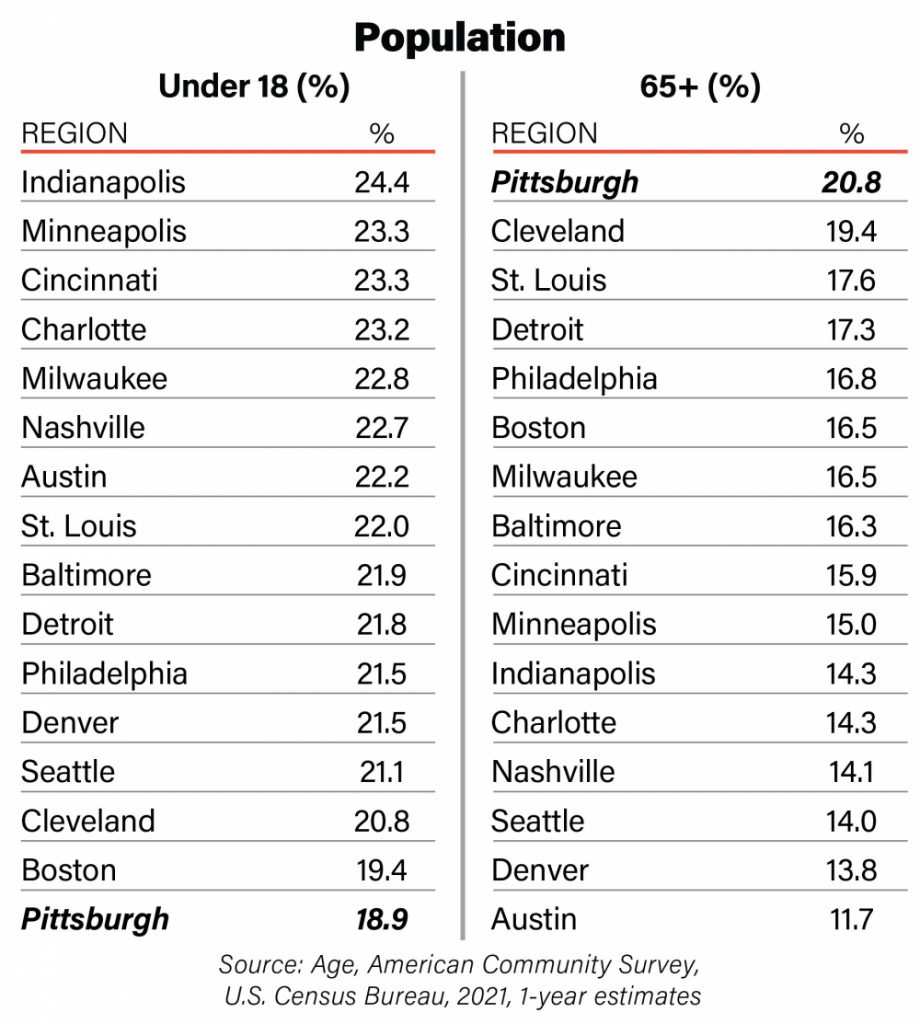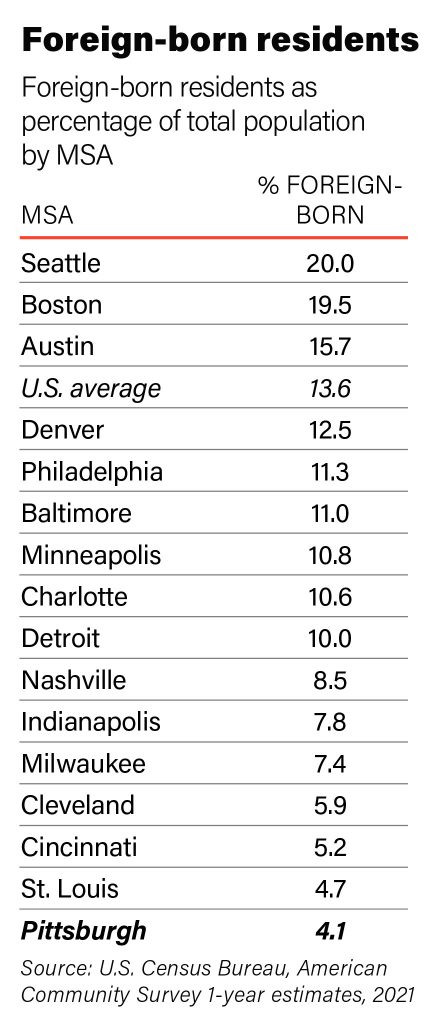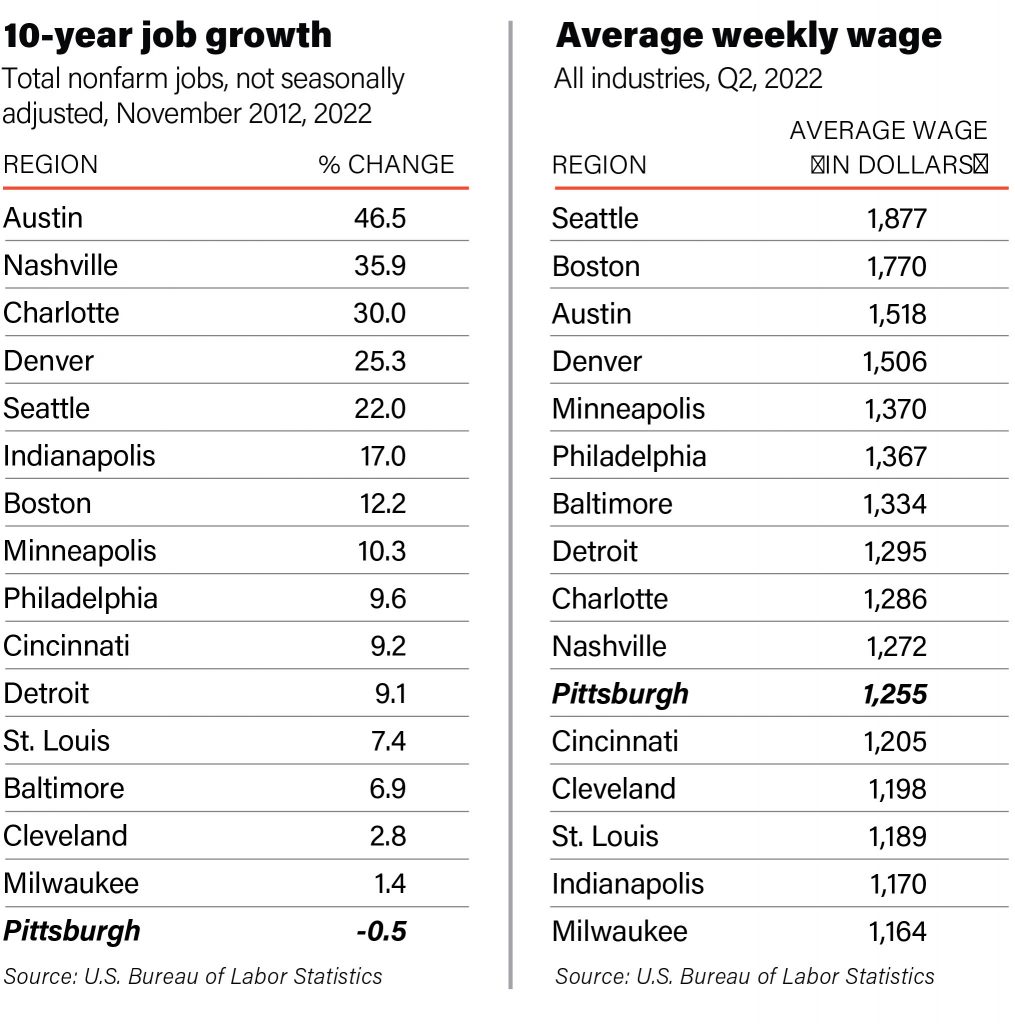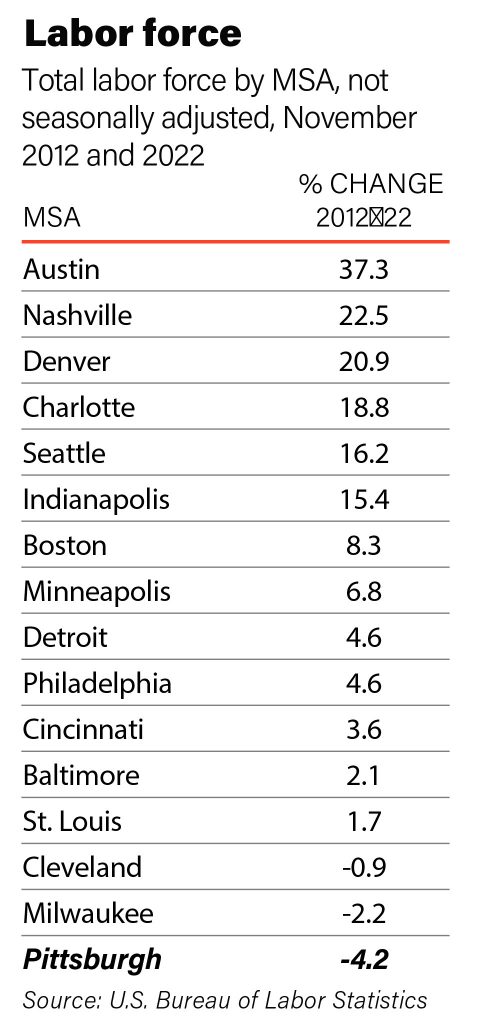The Game Plan

“Anything is possible when imagination and will coincide.”
Imagine Pittsburgh in 10 years as a vibrant, multi-cultural hub that has become a beacon for immigrants eager to start a new life in America, work hard, raise a family and get ahead.
Imagine if we harness the Pittsburgh diaspora and Pittsburgh becomes the dynamic nexus of a worldwide network of people who prize their Pittsburgh connections, with many moving back to build upon our great quality of life and intact social fabric, and others contributing to a global Pittsburgh network of social and economic ties.
Imagine if we make a vigorous, sustained effort to welcome the tens of thousands of bright, young university students who come to Pittsburgh each year and involve them in our city’s life so that when graduation looms, they want to look no further for a job and home than the city that treated them so well.
Imagine a Pittsburgh that believes in the promise of its high school students so much that it creates a Pittsburgh Conservation Corps for these young people to lead the way into a green and sustainable future by cleaning, beautifying and preparing their neighborhoods and our region for whatever climatic changes come our way.
Imagine a Pittsburgh in which the local news media pull together to spread a can-do message of future possibility that spurs Pittsburgh to regain its historic perch as the essential American city.
Finally, imagine that all of this becomes reality, and that Pittsburgh becomes a model for America, the template of a city that eschews toxic division and instead works together to build a sustainable and prosperous future for all.
These are the goals of Pittsburgh Tomorrow, a project designed to stop this region’s steady population losses, attract new people and breathe new vision and vitality into Pittsburgh’s future.
THE NEED
If you read the introduction of Pittsburgh Tomorrow in the Spring issue of Pittsburgh Quarterly, you’ll recall that the Pittsburgh region has been experiencing population loss that, if left unchecked, promises a vicious cycle of further economic decline and quality of life reduction.
With the industrial collapse of the early 1980s, some 150,000 young people left Pittsburgh for jobs elsewhere. They took their future children with them, so that now, we have the highest percentage of residents over 65 and the lowest percentage under 18 among 16 benchmark regions. Between 2012-2022, those regions saw an average job gain of 28 percent. Only one region actually lost jobs — Pittsburgh. And those losses are accelerating.
Perhaps most disturbing, among 284 U.S. metro areas in 2021, Pittsburgh had the largest natural population decline in the U.S., with 10,838 more deaths than births. Tampa/St. Pete was second, losing 9,291 people, and Bradenton/Sarasota was third, losing 6,643.

Pittsburgh has its issues — as do all cities — but unlike many places, Pittsburgh’s are solvable. It’s a great place to live with limitless possibilities. The problem isn’t that people are leaving. The problem is that more people are aging out of the workforce and dying than entering the workforce and being born.
Right now, cities everywhere are vying to attract workers. Our situation, however, is more urgent, and we won’t succeed in that competition if we keep doing what other places are doing. Unless we realize we face a slow-moving crisis that calls for bold and decisive action, we’ll be like the frog in the pot of water with a slowly rising temperature. By the time he realizes what’s happening, he’s cooked.
In that context in the Spring issue, we asked 100 regional leaders to give their best idea on how to stem the population decline and attract more people — and we asked readers to send in their ideas. So far, we’ve received hundreds of responses from across the country, with many ready to get involved. With their help, we’ve finalized the broad outlines of our strategy.
THE PLAN
Pittsburgh Tomorrow will focus on stopping population loss and attracting new people to ensure a prosperous and sustainable future. We’ll be an independent and entrepreneurial nonprofit, raising funds to incentivize projects and spur speed of execution.
With the complexity of Pittsburgh’s challenges, the public sector cannot succeed alone. We will work with the public and private sectors, aiming to augment efforts where they’re succeeding. Where issues aren’t being addressed or where there’s little progress, we’ll seek to bring new thinking to bear and solve problems.
Above all, we’ll attract new people by building on the strong sense of community that forms Pittsburgh’s foundation. We will beckon them to a welcoming Pittsburgh that realizes it needs people of all kinds.
IMMIGRANTS
Pittsburgh, the state of Pennsylvania and the nation have grown via immigration and, in recent years, no major city in the country has grown without significant immigration. Immigrants are one of two groups most likely to want to move to Pittsburgh. For them it will represent the United States and the land of opportunity.
Currently, however, foreign-born residents comprise just over 4 percent of the Pittsburgh region — the lowest of the benchmark regions and only 30 percent of the national average. So attracting immigrants may be our most obvious opportunity.
We will work to augment the efforts of groups currently working on this effort. And we will prepare our local population to welcome immigrants via a significant public messaging campaign. We’ll also play from strength, focusing particularly on countries from where we already have significant populations. Through an incentive program, we’ll also seek immigrants who can make immediate economic contributions.

PITTSBURGH EX-PATS
The other group most likely to relocate here are Pittsburgh ex-pats (“Boomerangers”), and with the advent of remote work, they represent a huge, untapped opportunity. Pittsburgh’s exceptional quality of life — its safety, schools, physical beauty, cultural life, cost of living, medical excellence, and small-town feel make it a great place to live and raise children.
We’ll seek to attract ex-pat business owners and entrepreneurs through financial incentives to move or start their businesses here. Similarly, we will create a major initiative to attract remote workers, especially targeting influencers and future leaders.
Another major prong will be creating a Pittsburgh Homecoming, inviting ex-pats back for a homecoming/reunion. Community groups will prepare and beautify neighborhoods, arts organizations will display their talents, and businesses will prepare job and internship fairs that culminate in a fall weekend/week that focuses, above all, on fun. However, it will also re-engage visitors and create a new interconnectivity. Some visitors may move back. Others may send their children to college here. Still others may hire Pittsburgh graduates. By harnessing and augmenting this Pittsburgh spirit, we will show what Pittsburgh is now and build on the fundamental attraction premise of Pittsburgh Tomorrow — that Pittsburgh is about community, connectivity and vitality.

COLLEGE & UNIVERSITY STUDENTS
The Pittsburgh region attracts more than 60,000 higher education students each year. They are here and represent a clear and present opportunity. We’ll connect with all local colleges and universities, but especially Pitt and CMU, which have roughly two-thirds of the students as well as the largest percentage of students not from the region — and therefore most likely to leave after graduation.
We’ll welcome students in a variety of ways and connect them to Pittsburgh’s cultural charms and business internships. Not unlike a dating relationship, we’ll make the case that we have what they want — and that we want them. This will involve developing college nights with discounted or free tickets at cultural and sporting events throughout the region. Given Pittsburgh’s demographics, there should no longer be an empty seat in the house. We’ll aim to spread this student discount to retailers.
We will partner with other efforts currently underway in this space and seek to dramatically accelerate their efforts. And we will hire a team whose job it is to build this program. On each campus, we’ll cultivate Pittsburgh committees comprising students — so that connecting with Pittsburgh becomes fun and the thing to do.

PITTSBURGH CONSERVATION CORPS
Reminiscent of the national Depression-era programs Civilian Conservation Corps and Works Progress Administration, we’ll create a Pittsburgh Conservation Corps in which students in Allegheny County high schools work on projects to clean up, beautify and build the natural resilience of their communities by picking up garbage, painting murals, and planting flowers and trees.
High school students believe they can make the world a better place, and they all need volunteer hours to get into college. Yet, from a civic perspective, we ask nothing of them.
The program will have four benefits. First, it will lead to actual and dramatic physical improvement, with students beautifying and improving both their neighborhoods and key regional places (Downtown, and regional trails for example).
Second, it will be part of a long-term “attract and retain” population strategy. Like the area’s college students, high schoolers can choose their futures. The Pittsburgh Conservation Corps will further embed Pittsburgh as “home” for these students. They will identify more with their own neighborhoods — “I planted that tree” — and with Pittsburgh — “I cleaned up Downtown” — and will take more ownership of this region.
Third, nothing like this exists in this country and it is sure to get major media attention. This is a huge opportunity to change the reality of Pittsburgh and its national image: from old and rustbelt to young and green.
MESSAGING
In Pittsburgh’s first Renaissance, Richard King Mellon and Mayor David Lawrence corralled and persuaded the private and public sectors to get behind the effort to remake Pittsburgh. It worked because Lawrence had a political machine and Mellon had tremendous influence among local businesses (owning shares and/or sitting on the boards of many).
It’s a different time, however, and such power concentrations no longer exist. Now we live in a media age, and given that reality, an essential part of Pittsburgh Tomorrow is the media partnership we are developing. Currently, a dozen media companies representing 25 different media outlets are willing to participate and spread the word about Pittsburgh Tomorrow and the effort to attract new people. As with the rest of the project, the messaging campaign will succeed if other companies that can reach local citizens, including social media, join in the effort, which will begin this summer.
Pittsburgh Tomorrow’s messaging will focus on issues that unite, not divide us. It couldn’t be more clear that for our economic future, we need more people of all kinds. So, if, for example, we want to build our diversity and immigrants, it’s easy to imagine messaging that prepares the community to welcome newcomers and people of all creeds and colors. And while we’ll seek to reach as much of the Pittsburgh community as possible, a key goal will be reaching opinion leaders, which will allow us to leverage our efforts.
It’s difficult to gauge the possible power the media has to unite Pittsburghers and revitalize this region.
FUNDRAISING
Pittsburgh Tomorrow may start with volunteers, but it will not succeed without paid staff, who are incentivized financially to make their part of the project succeed.
Clearly, fundraising will be key to this project’s success. We will seek to raise money through a campaign that targets several groups. The first is successful Pittsburghers, here and elsewhere. They are the most likely to decisively judge Pittsburgh Tomorrow by the cogency of its plan and the people involved. They know the issues Pittsburgh faces and won’t need a committee to decide whether this effort to help their hometown merits their support.
We will also contact local corporations and businesses, which will be among Pittsburgh Tomorrow’s major beneficiaries. They need customers and they need workers, and turning around current population trends with each is essential to their futures.
On the grassroots level, we’ll create a major Pittsburgh crowdsourcing initiative akin to a Pittsburgh March of Dimes. We will publicize this effort through our messaging partnership.
In Pittsburgh, fundraising campaigns usually start with our philanthropic foundations, which control about $15 billion. Much of that was bequeathed for use as civic risk capital to ensure the future of the Pittsburgh region. Unlike other campaigns, however, we will only approach Pittsburgh’s foundations if we first succeed raising funds from the community. If our program isn’t good enough to get Pittsburghers behind it, the fact is, it won’t deserve to exist.
However, if the community does support Pittsburgh Tomorrow, we will then approach local foundations, confident that they will add their tremendous financial might and vision to magnify this project’s reach.
We’re just getting started, but we hope and expect to move fast. If you’d like to be part of it and want to help make Pittsburgh Tomorrow happen, please email pghtomorrow@pittsburghquarterly.com
Pittsburgh Tomorrow begins today.


